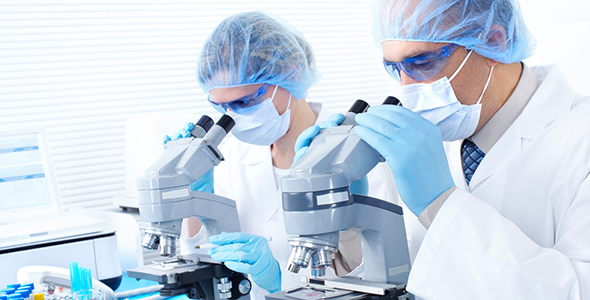By the bioMérieux Connection Editors
This is part 3 of a 3-part series about understanding viruses and how our immune system fights them so that we can develop diagnostics, treatments, and vaccines.
Read part 1: What are Viruses and How Do They Infect Us?
Read Part 2: How Our Immune System Works to Fight Viruses
Diagnostic Testing
Because viruses require host cells to replicate and survive, we can’t identify viral infections in all of the same ways that we can identify a bacterial or a fungal infection. Bacteria and fungi can function and reproduce on their own, so it’s possible to make them grow and reproduce outside our bodies as long as we give them the right environment, such as a bottle or petri dish. That growth process is called microbial culture, and it is a major component of every clinical laboratory’s work.
Replicating a virus is more complicated because host cells must be cultured, and the virus replicated inside the host cells. The process is critical for research and has also been used in clinical diagnostics for patients. However, a molecular testing process called real-time polymerase chain reaction (RT-PCR), which allows the virus’s genetic material to be quickly replicated from a patient sample, has replaced viral culture in many laboratories. To develop RT-PCR tests, researchers must first identify the virus’s unique genetic sequences to design the chemicals to replicate them.
Another type of diagnostic test, called a serologic antibody test, is designed to find out whether a patient has antibodies against a specific pathogen. Developing serologic antibody tests and testing procedures requires understanding the genetic makeup of the pathogen as well as the immune system’s response to the pathogen. Researchers must identify the antibodies that the body’s B cells make in response to a specific pathogen. Besides identifying which antibodies are present in response to infection, understanding their functions and how long they are present in the body provides a better understanding of what test results may mean. Without that information, the interpretation of test results is limited. This is a major reason why serologic test results for COVID-19 antibodies must still be interpreted with caution.
Treatment Development
Understanding pathogens and the body’s immune responses also has implications for developing treatment for infections, both for treatments that target the pathogen specifically, and for supportive care. In the case of COVID-19, researchers are exploring whether it is possible to effectively treat infections using antibodies from patients who have recovered.
The body’s immune response also plays a role in disease progression, and in some cases can cause harm if the response becomes abnormal or impaired. For example, a bacterial infection can lead to sepsis, a condition where the body’s immune system malfunctions, which can be deadly. In COVID-19, clinicians and researchers have suggested that an immune response called a “cytokine storm” may be partly responsible for many deaths. By knowing how the body’s immune system responds to an infection, COVID-19 or otherwise, physicians can make treatment decisions to help eliminate or mitigate adverse effects.
Vaccine Development
The goal of vaccines is to leverage the body’s natural immune system processes to protect you from diseases. Vaccines trigger your adaptive immune system in different ways, such as with proteins from a pathogen, using an inactive pathogen, and other methods. Because vaccines introduce foreign substances, your B cells can see them and respond by making antibodies. Some of your B cells then retain the memory of those proteins so that your body can more quickly make antibodies when you encounter the real pathogen in the future.
Vaccines give you all of the benefits of an immune response without the risks that come with actually getting sick. This is especially important for pathogens that are frequently deadly or that have high rates of complications, such as measles, HPV, Ebola, pertussis, and tetanus.
However, scientists and clinicians must understand the specific factors at play in the immune system and the pathogen to leverage them for a vaccine. The complexity of the immune system is a major reason why vaccine development is so lengthy and difficult. Understanding a new human pathogen also takes a significant amount of research because we can’t rely on existing knowledge, unlike with common pathogens such as the flu. Researchers are attempting to condense the development timeline for a COVID-19 vaccine, but it’s important to remember that most vaccines take years to develop and become available to the public.
Scientific Research Makes Modern Healthcare Possible and Saves Lives
All of the healthcare advances that we have made in the 20th and 21st centuries—the ability to detect and identify microbes, the advent of antibiotics, vaccines, and so much more, are built on scientific research. This not only includes clinical research and clinical trials, but especially “basic” science, which focuses on the underlying mechanisms and processes of everything from biology, to chemistry, to physics. Without basic scientific research, we would not have the building blocks we need to come up with new diagnostics, treatments, or preventives. We would not be able to meet new healthcare challenges or battle novel pathogens like the SARS-CoV-2 virus. We must continue to invest significantly in science—both education and research—to meet the challenges of today and tomorrow.
Opinions expressed in this article are not necessarily those of bioMérieux, Inc.



